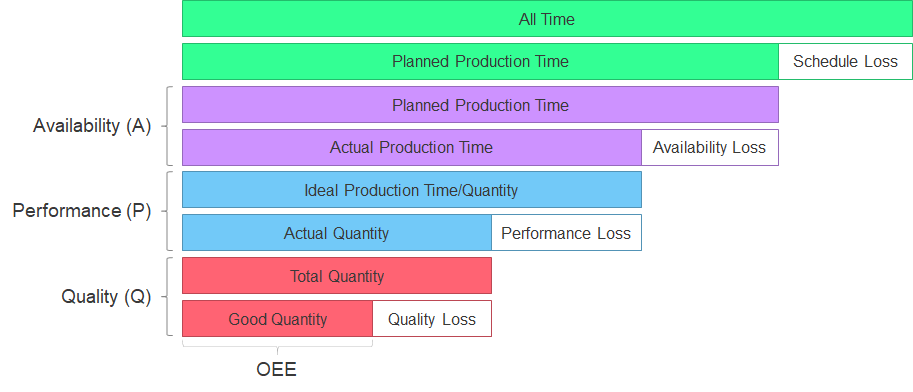Overall Equipment Effectiveness (OEE)
Overall Equipment Effectiveness (OEE) is a standard used to measure manufacturing productivity by identifying the percentages of manufacturing time that is truly productive. An OEE score of 100% means only good parts are produced (100% Quality), as fast as possible (100% Performance), with no stop time (100% Availability).
To calculate the OEE value, the three underlying factors of Availability (A), Performance (P) and Quality (Q) must first be calculated. The OEE value is then calculated as:


OEE Calculation
In IFS Cloud, OEE is calculated for work center resources over a period of one workday according to the work center calendar. I.e., all time and quantity transactions registered on a work center resource from shop order and production schedule reports with the same transaction date are considered in the OEE calculation.
Availability
Availability is the time the machine is planned for production but was stopped with a downtime cause classified as availability loss, or was reporting setup. The value is calculated as:

Planned Production Time is calculated as:

- Scheduled Working Time - The number of working hours for the work center resource according to the work center calendar.
- Schedule Loss Downtime - Reported downtime for downtime causes with OEE Factor = Schedule Loss.
Actual Production Time is calculated differently depending on the option selected when the calculation was ordered:
Option A:

- Availability Loss Downtime - Reported downtime for downtime causes with OEE Factor = Availability Loss.
- Setup Resource Hours - Reported machine setup time considering the resource share.
Option B:

- Resource Hours - Reported machine runtime considering the resource share.
- Performance Loss Downtime - Reported downtime for downtime causes with OEE Factor = Performance Loss.
Performance
Performance represents the quantity the machine actually produced relative what it ideally could have produced during the actual production time. This can also be expressed as the time it ideally should have taken to produce the actual quantity relative the time it actually took. The value is calculated as:

Ideal Production Time is calculated as:

- Run Factor - The machine run factor from the shop order or routing operation in hours per unit. The routing operation is used for quantities reported for production schedules. If the factor unit is defined as Hours for the operation, the value will not be multiplied with the actual quantity. If the factor unit is Units/Hour, the value is first converted to Hours/Unit. The run factor will also be adjusted according to the defined Efficiency for the work center resource. I.e., if the run factor is 1 unit/hour and the resource efficiency is 80%, the run factor used in the calculation is 0.8 units/h.
- Actual Quantity - The sum of the quantity reported as completed and scrapped for the shop order operation or production schedule.
Note: If you setup the run factor of the operation to reflect the ideal cycle time, the Efficiency value defined for the operation can be adjusted to a value less than 100% to plan with a slower, more realistic cycle time.
Quality
Quality represents the ratio between good parts produced relative the total quantity produced. The value is calculated as:

Good Quantity is calculated as:

- Total Quantity - The sum of the quantity reported as completed and scrapped.
- Scrapped Quantity - The quantity reported as scrap.
Total Effective Equipment Performance
Total Effective Equipment Performance (TEEP) is a measure closely related to OEE that measures the performance against total calendar hours whilst OEE only considers the planned production time.
TEEP is calculated as:

Utilization is calculated as:

- All Time is 24 hours since the OEE and TEEP values are always calculated per day.
Limitations
- The references shop order operation which a quantity transaction reference must still exist (must not have been included in a mass delete).
- The references production schedule receipt which a quantity transaction reference must not have been moved to production schedule reports history.
- A work center used to report production schedule must contain only one valid resource on the transaction date. If the work center contains several valid resources the time and quantity transactions are not booked against any resource. Hence, the transactions will not be considered in any OEE calculation.
- The performance calculation is using the routing/shop order operation run factor. This may not represent the true ideal cycle time.
- Reworked quantities are not considered in the quality calculation.